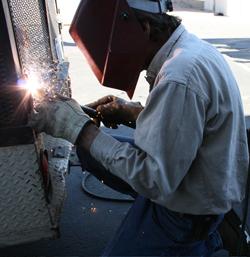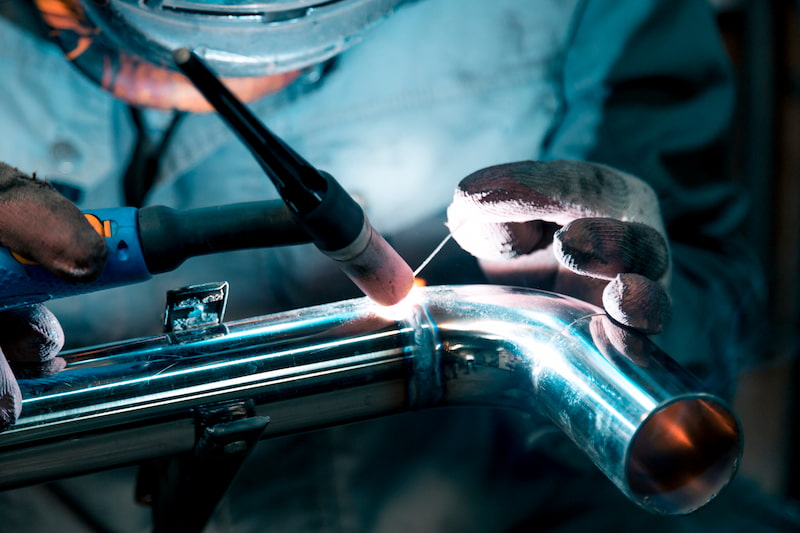Everything about Welding: Trick Insights Into Techniques and Finest Practices for Success
Welding incorporates a variety of methods, each suited for certain products and applications. Understanding these techniques, such as GMAW, SMAW, and TIG, is necessary for accomplishing ideal results. The right tools and safety and security techniques can not be forgotten. As preparation and fixing play crucial functions in the welding procedure, understanding these components can substantially enhance the top quality of the end product. What are the essential variables that ensure a successful weld?
Understanding Various Welding Techniques
Welding strategies incorporate a selection of methods, each matched to certain applications and materials. Amongst the most common techniques are Gas Steel Arc Welding (GMAW), Protected Steel Arc Welding (SMAW), and Tungsten Inert Gas Welding (TIG) GMAW, additionally called MIG welding, is preferred for its rate and convenience, making it ideal for slim products. SMAW, or stick welding, is preferred for its simpleness and effectiveness in outside environments, specifically with thicker steels. TIG welding supplies precision and control, making it suitable for complex work and non-ferrous metals (Belgrade Fabrication). Each strategy has its unique benefits and factors to consider, permitting welders to pick the very best technique based on the task's needs, material kind, and wanted outcomes. Recognizing these techniques is important for effective welding
Essential Welding Equipment and Tools
While numerous welding techniques require certain abilities, the best devices and tools are just as crucial for attaining high quality results. Necessary welding tools includes welding equipments, which differ relying on the strategy-- such as MIG, TIG, or stick welding. Protective gear, consisting of handwear covers, headgears, and aprons, assurances safety and security and comfort throughout the process. Furthermore, clamps and components help protect materials in position, guaranteeing accuracy in welds. Consumables like welding rods, cord, and shielding gas are additionally critical parts that affect the quality of the weld. Devices such as cutters and mills assist in surface preparation and post-weld completing, contributing to a specialist end result. Buying premium tools eventually boosts the efficiency and effectiveness of welding projects.
Security Practices in Welding
Appropriate security practices are essential in the welding sector to secure workers from prospective dangers. Welders should put on suitable personal protective equipment (PPE), including headgears with correct shading, handwear covers, and flame-resistant garments. Appropriate air flow is essential to lower exposure to damaging fumes and gases created throughout the welding procedure. Additionally, workers need to be learnt the right handling of welding equipment to avoid crashes. Fire precaution, such as keeping combustible materials away from the welding location and having fire extinguishers easily offered, are needed. Routine examinations of tools and workspaces can aid determine potential threats before they result in accidents. By sticking to these safety methods, welders can create a more secure working setting and reduce risks connected with their profession.
Preparing Materials for Welding
Preparing products for welding is a vital action that greatly influences the high quality and integrity of the last item (Belgrade). Correct preparation involves cleaning up the surface areas to eliminate contaminants such as dust, oil, and rust, which can jeopardize the weld. Strategies such as grinding, fining sand, or utilizing solvents are generally employed to achieve a tidy surface. In addition, ensuring that the products fit with each other snugly is crucial; gaps can lead to weak welds. It's additionally essential to consider the alignment and positioning of the components, as this will influence the ease of welding and the final end result. Selecting the proper filler product and guaranteeing compatibility with the base steels is crucial for attaining strong, sturdy welds.
Tips for Achieving High-Quality Welds
Accomplishing premium welds requires interest to information and adherence to finest techniques throughout the welding procedure. Appropriate joint prep work is necessary, making certain surfaces are tidy and free from pollutants. Choosing the proper filler product and welding technique based upon the base steels is essential for suitable bonding. Keeping constant travel speed and angle while welding can prevent defects and promote uniformity. In addition, controlling heat input is crucial; too much warm can result in warping and compromised joints. If necessary, routinely evaluating the welds during the process enables for immediate adjustments. Utilizing ideal post-weld therapies, such as cleaning and stress and anxiety alleviation, can boost the sturdiness and integrity of the weld, eventually making certain an effective end result.
Troubleshooting Typical Welding Issues
Welding commonly offers difficulties that can impact the high quality and integrity of the final product. Usual problems such as porosity, inconsistent weld grains, and overheating can arise, each requiring certain fixing methods. Understanding these troubles is vital for welders to enhance their skills and achieve optimal results.
Porosity Problems Described
Although porosity can frequently be ignored, it stays a critical concern in welding that can compromise the integrity of an ended up product. Porosity refers to the existence of little gas pockets within the weld grain, which can damage the joint and lead to premature failure. This trouble usually develops from pollutants, dampness, or incorrect securing gas coverage during the welding procedure. To mitigate porosity, welders must confirm that the base products are completely dry and clean, utilize appropriate shielding gases, click for info and keep regular welding criteria. Consistently inspecting the tools and atmosphere can likewise help identify potential issues before they materialize in the weld. Addressing porosity efficiently is essential for accomplishing strong, durable welds that meet high quality standards.

Inconsistent Weld Beans
Inconsistent weld beads can greatly affect the top quality and stamina of a finished item. Different aspects add to this issue, consisting of inappropriate travel rate, wrong amperage setups, and inconsistent electrode angles. When the welder moves as well quickly, a grain may appear narrow and do not have penetration, while relocating also gradually can create extreme accumulation. In addition, utilizing the wrong amperage can lead to either damaging or too much spatter, both of which compromise weld integrity. The welder's strategy, such as inconsistent torch activity, can additionally cause unequal grain look. To minimize these problems, welders should concentrate on keeping steady, regulated motions and guaranteeing appropriate equipment settings to accomplish uniformity in their welds. Consistency is vital to attaining strong and reliable welds.
Getting Too Hot and Warping Issues
Extreme heat throughout the welding procedure can result in significant overheating and warping problems, affecting the architectural stability of the work surface. These issues often manifest as distortion, which can compromise positioning and fit-up, making further setting up testing. Variables adding to overheating include the option of welding specifications, such as voltage and travel speed, along with the kind of material being welded. To reduce these issues, welders should preserve regular traveling rate and proper warm input while monitoring the workpiece temperature level. In addition, preheating or post-weld warm treatment can help ease stresses brought on by quick air conditioning - Montana Mobile Welding and Repair Belgrade Welding. Regular inspection and adherence to best techniques are vital in protecting against getting too hot and making sure the long life and dependability of bonded frameworks
Often Asked Concerns
What Are the Occupation Opportunities in the Welding Industry?
The welding market offers diverse profession possibilities, consisting of settings as welders, inspectors, instructors, and engineers. Specialists can operate in production, building and construction, aerospace, and automobile industries, gaining from strong demand and affordable incomes in different duties.
How Can I Enhance My Welding Rate Without Compromising Top Quality?
To enhance welding rate without giving up quality, one must practice effective methods, maintain equipment, maximize settings, and boost hand-eye coordination. Regular training and looking for feedback can additionally significantly contribute to accomplishing quicker, top notch welds.
What Qualifications Are Readily Available for Welders?
Countless accreditations exist for welders, consisting of those from the American Welding Culture (AWS), the National Facility for Building Education And Learning why not try this out and Research Study (NCCER), and numerous industry-specific companies. These credentials improve employability and demonstrate skill effectiveness.
How Does Welding Affect the Qualities of Metals?
Welding affects the residential or commercial properties of steels by altering their microstructure, which can lead to changes in hardness, stamina, and ductility. Warm input and air conditioning rates throughout the process substantially affect these product features.
Can I Bonded Dissimilar Metals Together?
